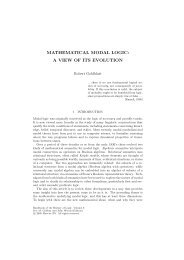Zermelo-Fraenkel Set Theory
Zermelo-Fraenkel Set Theory
Zermelo-Fraenkel Set Theory
Create successful ePaper yourself
Turn your PDF publications into a flip-book with our unique Google optimized e-Paper software.
CHAPTER 4. ORDINALS 25<br />
Proof. 1. Closure. Assume a ∈ T(OR). I.e.: a ∈ TR, and a ⊂ OR = TRR ∩ G. Then<br />
a ∈ TRR, a ∈ G (see Exercise 16 p. 10), and a ∈ OR.<br />
2. Induction. Aiming for a contradiction, assume that T(X) ⊂ X, α ∈ OR, and<br />
α ∉ X.<br />
Claim: α ∈ T(X) (and contradiction).<br />
Proof: (i) α ∈ TR: obvious.<br />
(ii) α ⊂ X: for if not, then some y ∈ α − X exists. Then y ∈ G (again, see Exercise 16<br />
p. 10). Hence, y ∈ α − X exists s.t. y ∩ (α − X) = ∅.<br />
Claim: y ∈ T(X) (and contradiction).<br />
Proof: That y ∈ TR is obvious. Also, y ⊂ X: for if z ∈ y, then z ∈ α, hence z ∈ X. □<br />
From now on, small greek letters usually denote ordinals.<br />
Definition 4.4 α < β ≡ def α ∈ β.<br />
□<br />
Induction for OR, that is: Theorem 4.3.2, is usually presented in the following guise.<br />
Theorem 4.5 “Transfinite Induction”:<br />
If K ⊂ OR is such that ∀α ∈ OR(∀β < α(β ∈ K) ⇒ α ∈ K), then OR ⊂ K.<br />
Proof. Assume that ∀α(∀β < α(β ∈ K) ⇒ α ∈ K).<br />
Claim: T(OR ∩ K) ⊂ OR ∩ K.<br />
From this, by Induction, we get that OR ⊂ OR ∩ K, and the result follows.<br />
Proof of Claim: Suppose that a ∈ T(OR ∩ K). Since OR ∩ K ⊂ OR, we have that<br />
T(OR ∩ K) ⊂ T(OR) = OR; hence a ∈ OR. In order that a ∈ K, it suffices (by<br />
assumption on K) to show that ∀β < a(β ∈ K), that is: a ⊂ K. However, this is<br />
immediate from a ∈ T(OR ∩ K).<br />
□<br />
Theorem 4.6 < linearly orders 1 OR.<br />
Proof. Irreflexivity is immediate from transfinite induction. Transitivity is trivial. To<br />
show<br />
∀α∀β(α < β ∨ β < α ∨ α = β),<br />
we use Transfinite Induction. Thus, let α be an arbitrary ordinal, and assume as a (first)<br />
induction hypothesis that<br />
We have to show now, that<br />
∀α ′ < α∀β(α ′ < β ∨ β < α ′ ∨ α ′ = β).<br />
∀β(α < β ∨ β < α ∨ α = β).<br />
Again, we apply Transfinite Induction. This time, let β be an arbitrary ordinal, and<br />
assume as a second induction hypothesis that<br />
∀β ′ < β(α < β ′ ∨ β ′ < α ∨ α = β ′ ).<br />
1 A relation ≺ is a linear ordering of a class A if it is irreflexive, transitive, and for all a, b ∈ A: if a ≠ b,<br />
then either a ≺ b or b ≺ a holds.

















